Ottawa Charter and Health Promotion for Diabetes, Essay
VerifiedAdded on 2022/11/14
|11
|2610
|11
Essay
AI Summary
This essay examines the application of the Ottawa Charter for Health Promotion in the context of type 2 diabetes. It begins by outlining the prevalence and impact of type 2 diabetes, highlighting its significant burden on individuals and the healthcare system. The essay then delves into the five action areas of the Ottawa Charter: building healthy public policy, creating supportive environments, strengthening community action, developing personal skills, and reorienting health services. For each area, the essay provides specific strategies that nursing professionals can implement to address the challenges of type 2 diabetes. These strategies include advocating for policies that support healthy eating and physical activity, fostering community-based health education programs, empowering individuals to manage their condition, and reorienting healthcare services toward prevention. The essay emphasizes the importance of a multifaceted approach to health promotion, underscoring the crucial role of nurses in improving diabetes outcomes and overall public health. It concludes by reiterating the significance of the Ottawa Charter as a guiding framework for effective health promotion interventions.
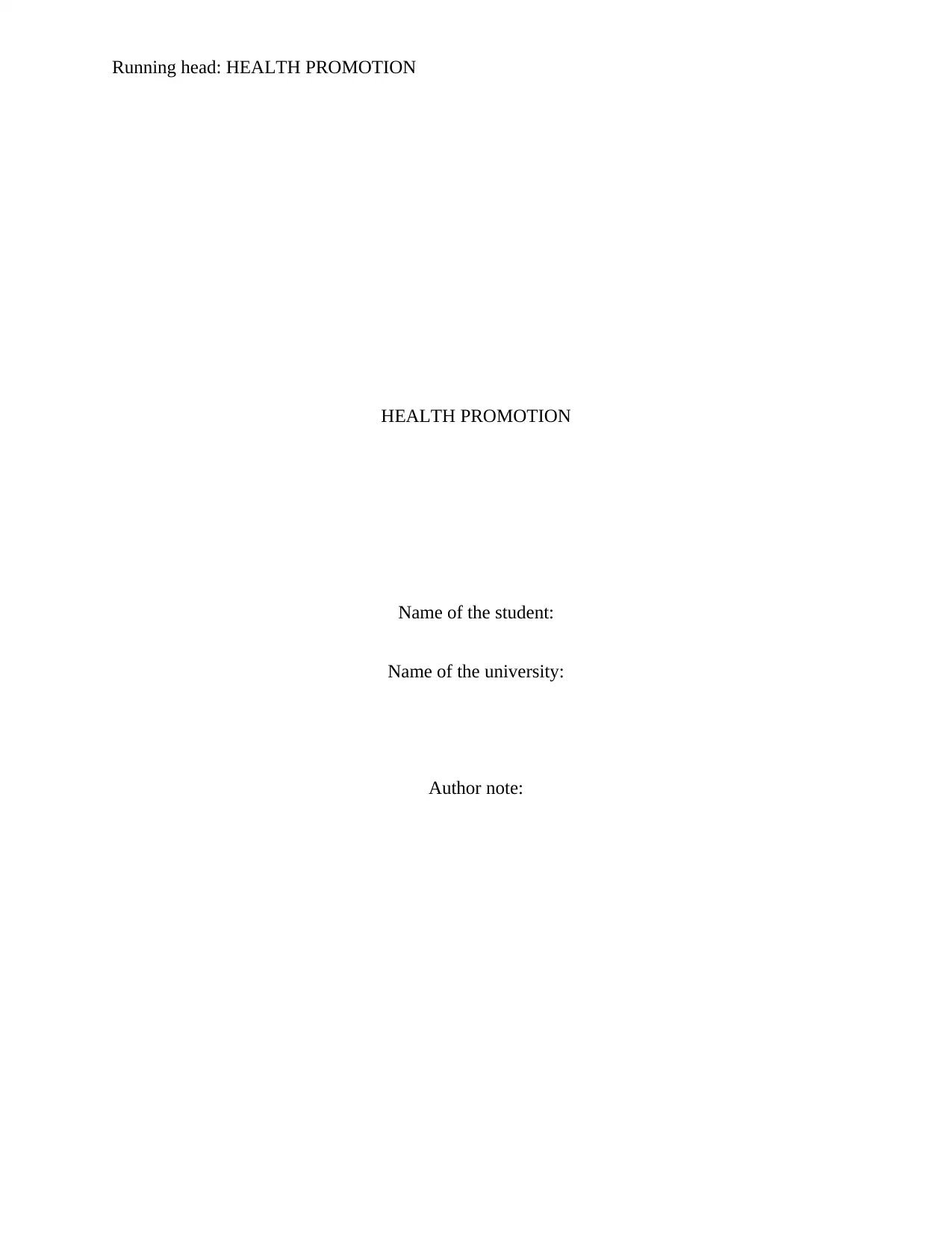
Running head: HEALTH PROMOTION
HEALTH PROMOTION
Name of the student:
Name of the university:
Author note:
HEALTH PROMOTION
Name of the student:
Name of the university:
Author note:
Paraphrase This Document
Need a fresh take? Get an instant paraphrase of this document with our AI Paraphraser

1
HEALTH PROMOTION
Introduction:
The Ottawa charter can be described as the global health milestone that remains a vital
reference for health promotion. The Charter identifies five important components of health
promotion action and prerequisites for health that can act as the guiding framework for
healthcare promotions (Agide & Shakibazadeh, 2018). Nursing professionals can follow the
action areas to develop interventions that satisfy each of the action areas to mange disorder and
mitigate the negative outcomes on patients as well as on entire communities. Diabetes type-2 had
become one of the most dreaded health disorders in the nation which had created huge burden on
the nation’s economy besides affecting quality of life of people (Peimani et al., 2019). Hence,
Ottawa charter needs to be implemented for developing health promotion programs against the
disorder. Health promotion can be described as the procedure that enable people in increasing
their control and improve their health. The nursing professionals have the responsibility of
contributing towards the society by developing health promotion sessions that enable people to
develop healthy lifestyle and health behaviors. This assignment would show how the five action
areas of the Ottawa charter can be used as a guiding framework by nursing professionals so that
effective care interventions and healthcare strategies are developed for people and communities.
Diabetes type 2 and its prevalence in the nation:
The total number of people suffering from diabetes mellitus in the year 2014-2015 is
around 1.2 million aged 2 and over. Among this number of people, 855 of the people are seen to
be suffering from diabetes type-2. This accounts for about 100200 people in the nation suffering
from diabetes type-2 (Department of Health, 2016). There were about 16400 people in the nation
who had been hospitalized due to diabetes and among them 55% of the people had been
HEALTH PROMOTION
Introduction:
The Ottawa charter can be described as the global health milestone that remains a vital
reference for health promotion. The Charter identifies five important components of health
promotion action and prerequisites for health that can act as the guiding framework for
healthcare promotions (Agide & Shakibazadeh, 2018). Nursing professionals can follow the
action areas to develop interventions that satisfy each of the action areas to mange disorder and
mitigate the negative outcomes on patients as well as on entire communities. Diabetes type-2 had
become one of the most dreaded health disorders in the nation which had created huge burden on
the nation’s economy besides affecting quality of life of people (Peimani et al., 2019). Hence,
Ottawa charter needs to be implemented for developing health promotion programs against the
disorder. Health promotion can be described as the procedure that enable people in increasing
their control and improve their health. The nursing professionals have the responsibility of
contributing towards the society by developing health promotion sessions that enable people to
develop healthy lifestyle and health behaviors. This assignment would show how the five action
areas of the Ottawa charter can be used as a guiding framework by nursing professionals so that
effective care interventions and healthcare strategies are developed for people and communities.
Diabetes type 2 and its prevalence in the nation:
The total number of people suffering from diabetes mellitus in the year 2014-2015 is
around 1.2 million aged 2 and over. Among this number of people, 855 of the people are seen to
be suffering from diabetes type-2. This accounts for about 100200 people in the nation suffering
from diabetes type-2 (Department of Health, 2016). There were about 16400 people in the nation
who had been hospitalized due to diabetes and among them 55% of the people had been
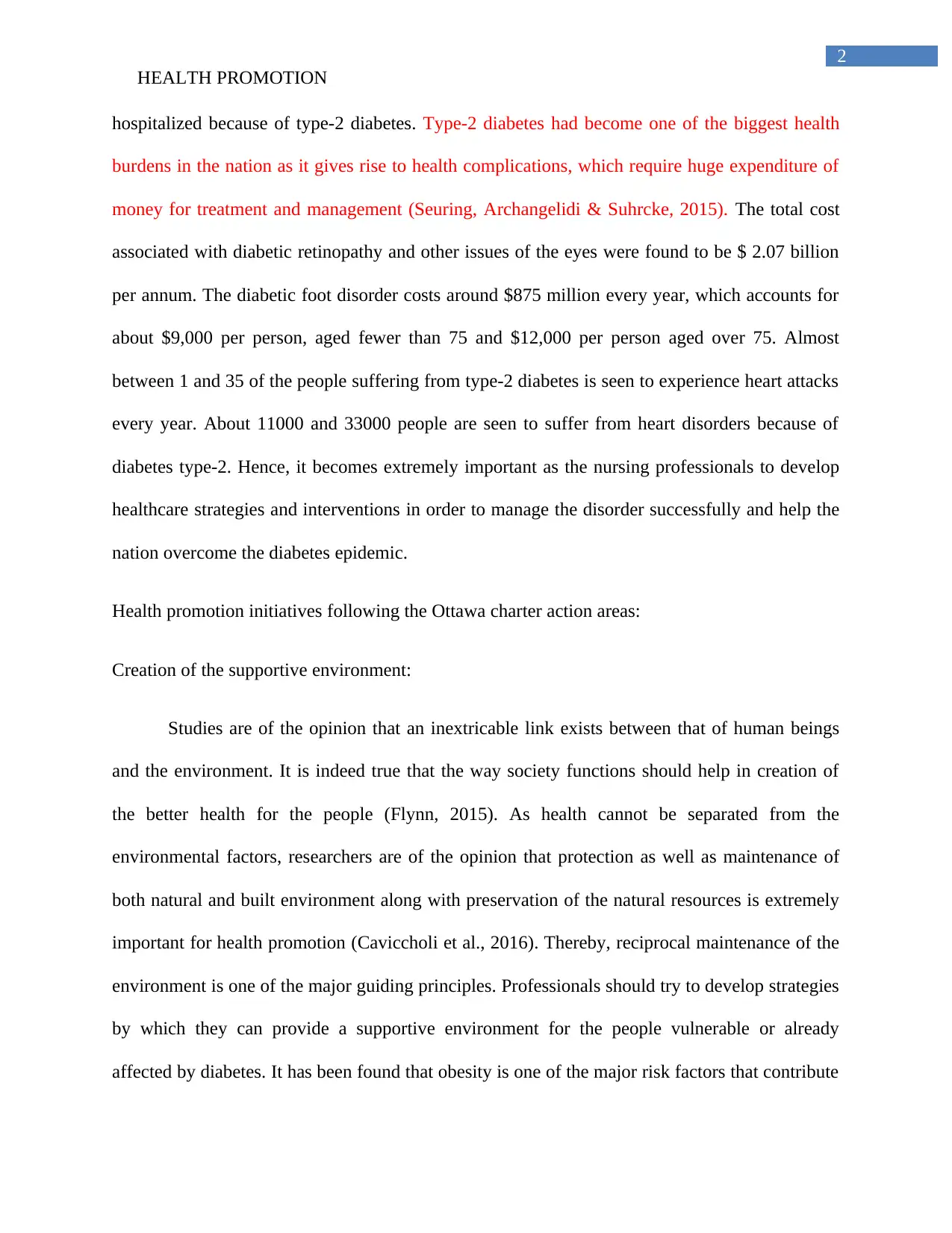
2
HEALTH PROMOTION
hospitalized because of type-2 diabetes. Type-2 diabetes had become one of the biggest health
burdens in the nation as it gives rise to health complications, which require huge expenditure of
money for treatment and management (Seuring, Archangelidi & Suhrcke, 2015). The total cost
associated with diabetic retinopathy and other issues of the eyes were found to be $ 2.07 billion
per annum. The diabetic foot disorder costs around $875 million every year, which accounts for
about $9,000 per person, aged fewer than 75 and $12,000 per person aged over 75. Almost
between 1 and 35 of the people suffering from type-2 diabetes is seen to experience heart attacks
every year. About 11000 and 33000 people are seen to suffer from heart disorders because of
diabetes type-2. Hence, it becomes extremely important as the nursing professionals to develop
healthcare strategies and interventions in order to manage the disorder successfully and help the
nation overcome the diabetes epidemic.
Health promotion initiatives following the Ottawa charter action areas:
Creation of the supportive environment:
Studies are of the opinion that an inextricable link exists between that of human beings
and the environment. It is indeed true that the way society functions should help in creation of
the better health for the people (Flynn, 2015). As health cannot be separated from the
environmental factors, researchers are of the opinion that protection as well as maintenance of
both natural and built environment along with preservation of the natural resources is extremely
important for health promotion (Caviccholi et al., 2016). Thereby, reciprocal maintenance of the
environment is one of the major guiding principles. Professionals should try to develop strategies
by which they can provide a supportive environment for the people vulnerable or already
affected by diabetes. It has been found that obesity is one of the major risk factors that contribute
HEALTH PROMOTION
hospitalized because of type-2 diabetes. Type-2 diabetes had become one of the biggest health
burdens in the nation as it gives rise to health complications, which require huge expenditure of
money for treatment and management (Seuring, Archangelidi & Suhrcke, 2015). The total cost
associated with diabetic retinopathy and other issues of the eyes were found to be $ 2.07 billion
per annum. The diabetic foot disorder costs around $875 million every year, which accounts for
about $9,000 per person, aged fewer than 75 and $12,000 per person aged over 75. Almost
between 1 and 35 of the people suffering from type-2 diabetes is seen to experience heart attacks
every year. About 11000 and 33000 people are seen to suffer from heart disorders because of
diabetes type-2. Hence, it becomes extremely important as the nursing professionals to develop
healthcare strategies and interventions in order to manage the disorder successfully and help the
nation overcome the diabetes epidemic.
Health promotion initiatives following the Ottawa charter action areas:
Creation of the supportive environment:
Studies are of the opinion that an inextricable link exists between that of human beings
and the environment. It is indeed true that the way society functions should help in creation of
the better health for the people (Flynn, 2015). As health cannot be separated from the
environmental factors, researchers are of the opinion that protection as well as maintenance of
both natural and built environment along with preservation of the natural resources is extremely
important for health promotion (Caviccholi et al., 2016). Thereby, reciprocal maintenance of the
environment is one of the major guiding principles. Professionals should try to develop strategies
by which they can provide a supportive environment for the people vulnerable or already
affected by diabetes. It has been found that obesity is one of the major risk factors that contribute
⊘ This is a preview!⊘
Do you want full access?
Subscribe today to unlock all pages.

Trusted by 1+ million students worldwide
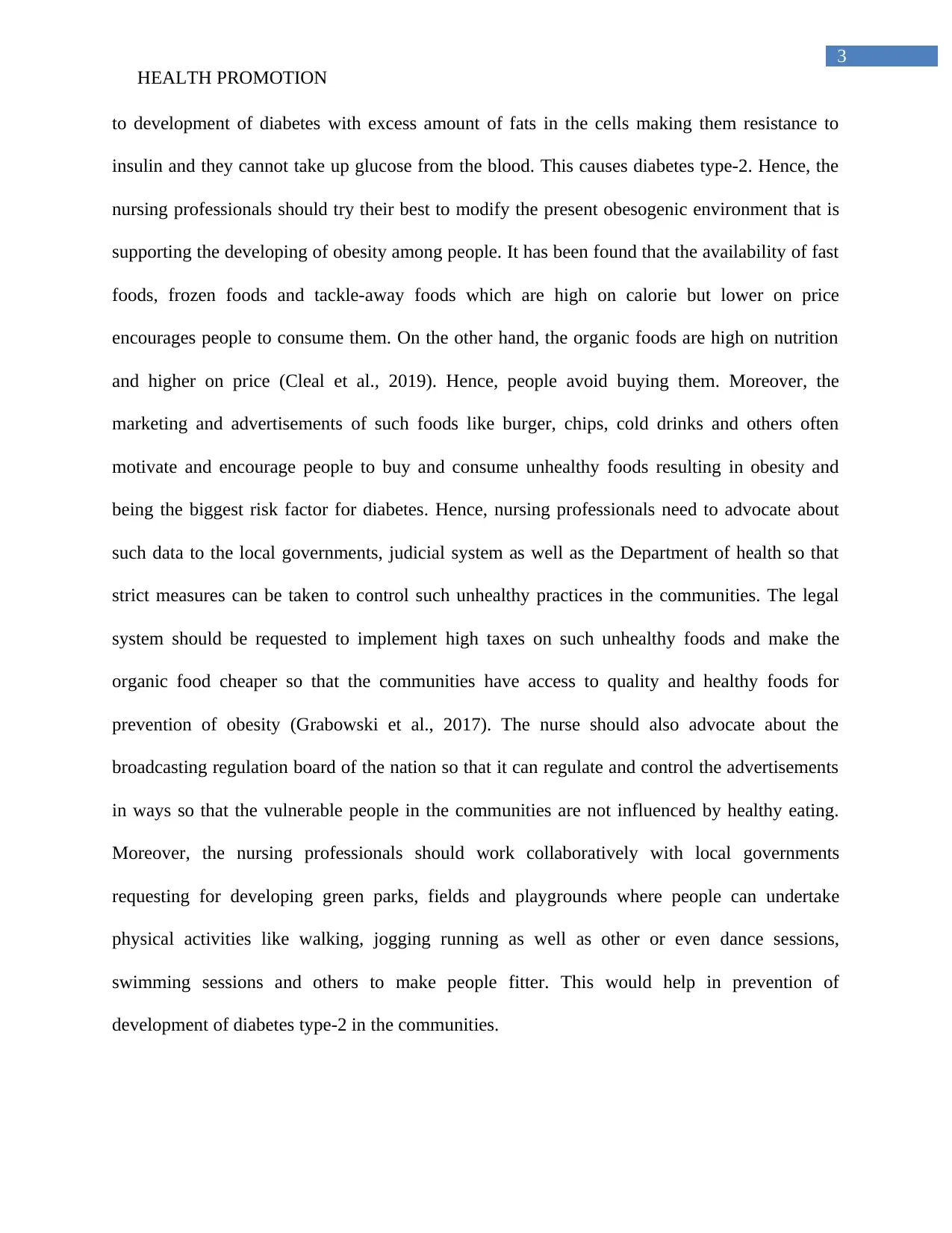
3
HEALTH PROMOTION
to development of diabetes with excess amount of fats in the cells making them resistance to
insulin and they cannot take up glucose from the blood. This causes diabetes type-2. Hence, the
nursing professionals should try their best to modify the present obesogenic environment that is
supporting the developing of obesity among people. It has been found that the availability of fast
foods, frozen foods and tackle-away foods which are high on calorie but lower on price
encourages people to consume them. On the other hand, the organic foods are high on nutrition
and higher on price (Cleal et al., 2019). Hence, people avoid buying them. Moreover, the
marketing and advertisements of such foods like burger, chips, cold drinks and others often
motivate and encourage people to buy and consume unhealthy foods resulting in obesity and
being the biggest risk factor for diabetes. Hence, nursing professionals need to advocate about
such data to the local governments, judicial system as well as the Department of health so that
strict measures can be taken to control such unhealthy practices in the communities. The legal
system should be requested to implement high taxes on such unhealthy foods and make the
organic food cheaper so that the communities have access to quality and healthy foods for
prevention of obesity (Grabowski et al., 2017). The nurse should also advocate about the
broadcasting regulation board of the nation so that it can regulate and control the advertisements
in ways so that the vulnerable people in the communities are not influenced by healthy eating.
Moreover, the nursing professionals should work collaboratively with local governments
requesting for developing green parks, fields and playgrounds where people can undertake
physical activities like walking, jogging running as well as other or even dance sessions,
swimming sessions and others to make people fitter. This would help in prevention of
development of diabetes type-2 in the communities.
HEALTH PROMOTION
to development of diabetes with excess amount of fats in the cells making them resistance to
insulin and they cannot take up glucose from the blood. This causes diabetes type-2. Hence, the
nursing professionals should try their best to modify the present obesogenic environment that is
supporting the developing of obesity among people. It has been found that the availability of fast
foods, frozen foods and tackle-away foods which are high on calorie but lower on price
encourages people to consume them. On the other hand, the organic foods are high on nutrition
and higher on price (Cleal et al., 2019). Hence, people avoid buying them. Moreover, the
marketing and advertisements of such foods like burger, chips, cold drinks and others often
motivate and encourage people to buy and consume unhealthy foods resulting in obesity and
being the biggest risk factor for diabetes. Hence, nursing professionals need to advocate about
such data to the local governments, judicial system as well as the Department of health so that
strict measures can be taken to control such unhealthy practices in the communities. The legal
system should be requested to implement high taxes on such unhealthy foods and make the
organic food cheaper so that the communities have access to quality and healthy foods for
prevention of obesity (Grabowski et al., 2017). The nurse should also advocate about the
broadcasting regulation board of the nation so that it can regulate and control the advertisements
in ways so that the vulnerable people in the communities are not influenced by healthy eating.
Moreover, the nursing professionals should work collaboratively with local governments
requesting for developing green parks, fields and playgrounds where people can undertake
physical activities like walking, jogging running as well as other or even dance sessions,
swimming sessions and others to make people fitter. This would help in prevention of
development of diabetes type-2 in the communities.
Paraphrase This Document
Need a fresh take? Get an instant paraphrase of this document with our AI Paraphraser
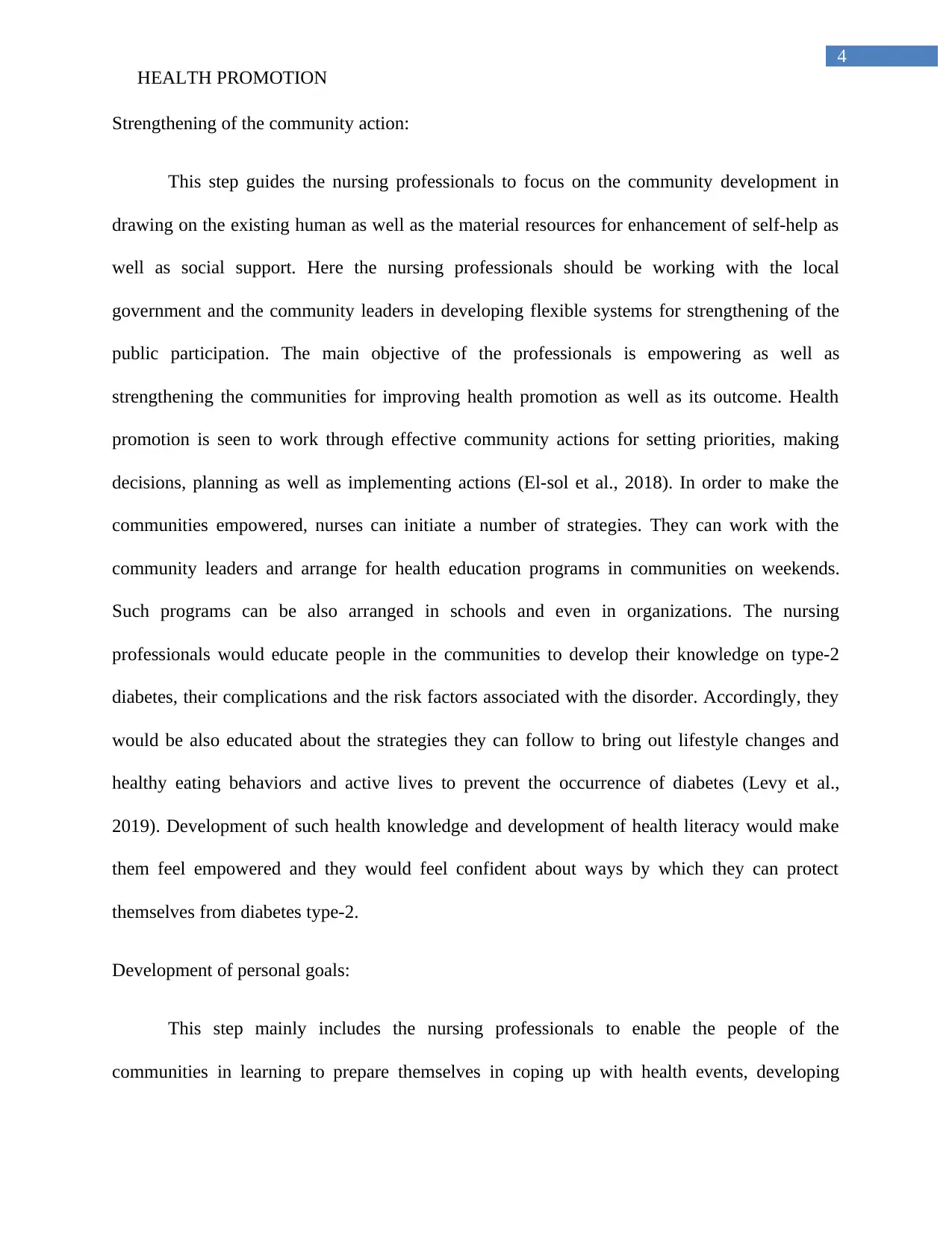
4
HEALTH PROMOTION
Strengthening of the community action:
This step guides the nursing professionals to focus on the community development in
drawing on the existing human as well as the material resources for enhancement of self-help as
well as social support. Here the nursing professionals should be working with the local
government and the community leaders in developing flexible systems for strengthening of the
public participation. The main objective of the professionals is empowering as well as
strengthening the communities for improving health promotion as well as its outcome. Health
promotion is seen to work through effective community actions for setting priorities, making
decisions, planning as well as implementing actions (El-sol et al., 2018). In order to make the
communities empowered, nurses can initiate a number of strategies. They can work with the
community leaders and arrange for health education programs in communities on weekends.
Such programs can be also arranged in schools and even in organizations. The nursing
professionals would educate people in the communities to develop their knowledge on type-2
diabetes, their complications and the risk factors associated with the disorder. Accordingly, they
would be also educated about the strategies they can follow to bring out lifestyle changes and
healthy eating behaviors and active lives to prevent the occurrence of diabetes (Levy et al.,
2019). Development of such health knowledge and development of health literacy would make
them feel empowered and they would feel confident about ways by which they can protect
themselves from diabetes type-2.
Development of personal goals:
This step mainly includes the nursing professionals to enable the people of the
communities in learning to prepare themselves in coping up with health events, developing
HEALTH PROMOTION
Strengthening of the community action:
This step guides the nursing professionals to focus on the community development in
drawing on the existing human as well as the material resources for enhancement of self-help as
well as social support. Here the nursing professionals should be working with the local
government and the community leaders in developing flexible systems for strengthening of the
public participation. The main objective of the professionals is empowering as well as
strengthening the communities for improving health promotion as well as its outcome. Health
promotion is seen to work through effective community actions for setting priorities, making
decisions, planning as well as implementing actions (El-sol et al., 2018). In order to make the
communities empowered, nurses can initiate a number of strategies. They can work with the
community leaders and arrange for health education programs in communities on weekends.
Such programs can be also arranged in schools and even in organizations. The nursing
professionals would educate people in the communities to develop their knowledge on type-2
diabetes, their complications and the risk factors associated with the disorder. Accordingly, they
would be also educated about the strategies they can follow to bring out lifestyle changes and
healthy eating behaviors and active lives to prevent the occurrence of diabetes (Levy et al.,
2019). Development of such health knowledge and development of health literacy would make
them feel empowered and they would feel confident about ways by which they can protect
themselves from diabetes type-2.
Development of personal goals:
This step mainly includes the nursing professionals to enable the people of the
communities in learning to prepare themselves in coping up with health events, developing
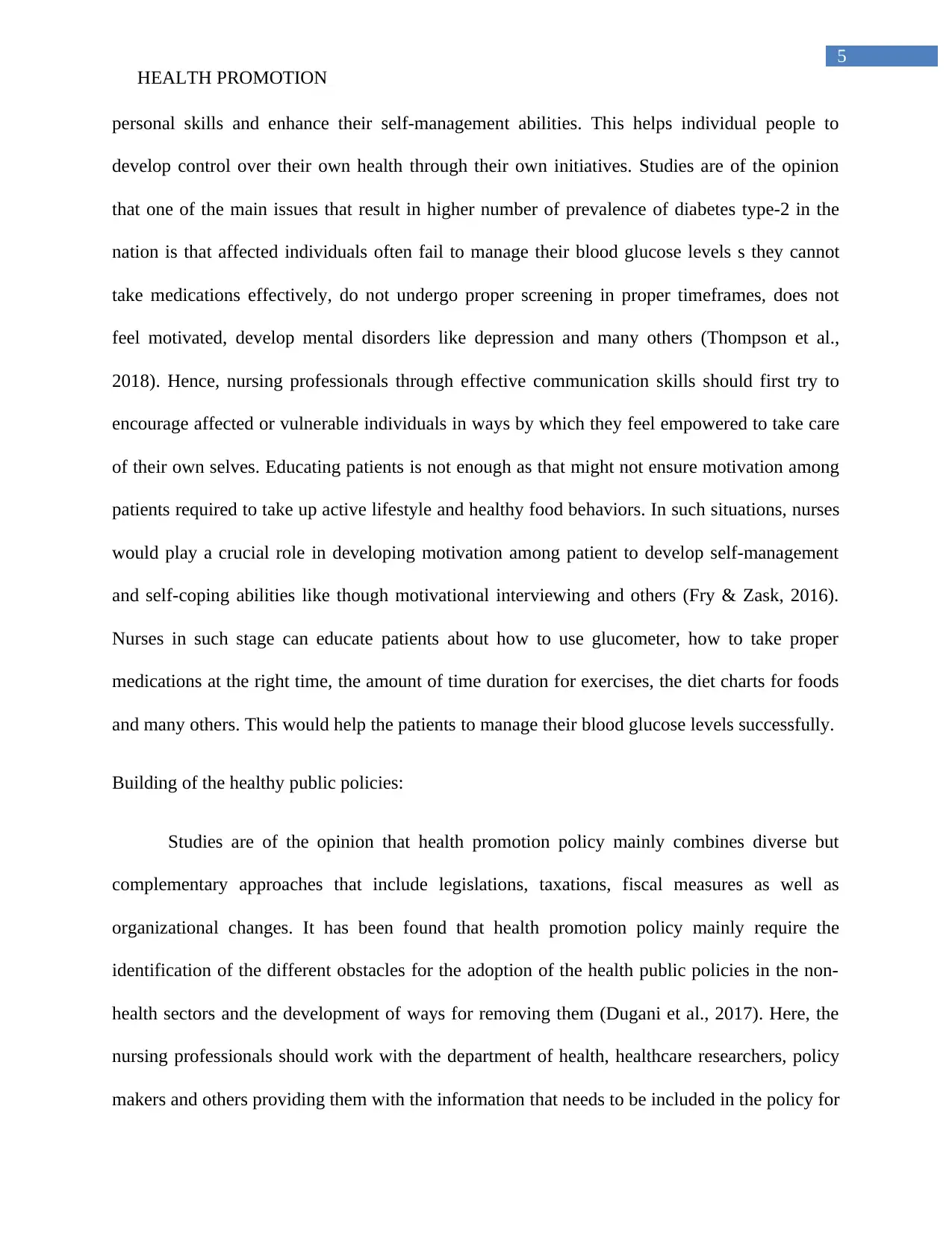
5
HEALTH PROMOTION
personal skills and enhance their self-management abilities. This helps individual people to
develop control over their own health through their own initiatives. Studies are of the opinion
that one of the main issues that result in higher number of prevalence of diabetes type-2 in the
nation is that affected individuals often fail to manage their blood glucose levels s they cannot
take medications effectively, do not undergo proper screening in proper timeframes, does not
feel motivated, develop mental disorders like depression and many others (Thompson et al.,
2018). Hence, nursing professionals through effective communication skills should first try to
encourage affected or vulnerable individuals in ways by which they feel empowered to take care
of their own selves. Educating patients is not enough as that might not ensure motivation among
patients required to take up active lifestyle and healthy food behaviors. In such situations, nurses
would play a crucial role in developing motivation among patient to develop self-management
and self-coping abilities like though motivational interviewing and others (Fry & Zask, 2016).
Nurses in such stage can educate patients about how to use glucometer, how to take proper
medications at the right time, the amount of time duration for exercises, the diet charts for foods
and many others. This would help the patients to manage their blood glucose levels successfully.
Building of the healthy public policies:
Studies are of the opinion that health promotion policy mainly combines diverse but
complementary approaches that include legislations, taxations, fiscal measures as well as
organizational changes. It has been found that health promotion policy mainly require the
identification of the different obstacles for the adoption of the health public policies in the non-
health sectors and the development of ways for removing them (Dugani et al., 2017). Here, the
nursing professionals should work with the department of health, healthcare researchers, policy
makers and others providing them with the information that needs to be included in the policy for
HEALTH PROMOTION
personal skills and enhance their self-management abilities. This helps individual people to
develop control over their own health through their own initiatives. Studies are of the opinion
that one of the main issues that result in higher number of prevalence of diabetes type-2 in the
nation is that affected individuals often fail to manage their blood glucose levels s they cannot
take medications effectively, do not undergo proper screening in proper timeframes, does not
feel motivated, develop mental disorders like depression and many others (Thompson et al.,
2018). Hence, nursing professionals through effective communication skills should first try to
encourage affected or vulnerable individuals in ways by which they feel empowered to take care
of their own selves. Educating patients is not enough as that might not ensure motivation among
patients required to take up active lifestyle and healthy food behaviors. In such situations, nurses
would play a crucial role in developing motivation among patient to develop self-management
and self-coping abilities like though motivational interviewing and others (Fry & Zask, 2016).
Nurses in such stage can educate patients about how to use glucometer, how to take proper
medications at the right time, the amount of time duration for exercises, the diet charts for foods
and many others. This would help the patients to manage their blood glucose levels successfully.
Building of the healthy public policies:
Studies are of the opinion that health promotion policy mainly combines diverse but
complementary approaches that include legislations, taxations, fiscal measures as well as
organizational changes. It has been found that health promotion policy mainly require the
identification of the different obstacles for the adoption of the health public policies in the non-
health sectors and the development of ways for removing them (Dugani et al., 2017). Here, the
nursing professionals should work with the department of health, healthcare researchers, policy
makers and others providing them with the information that needs to be included in the policy for
⊘ This is a preview!⊘
Do you want full access?
Subscribe today to unlock all pages.

Trusted by 1+ million students worldwide
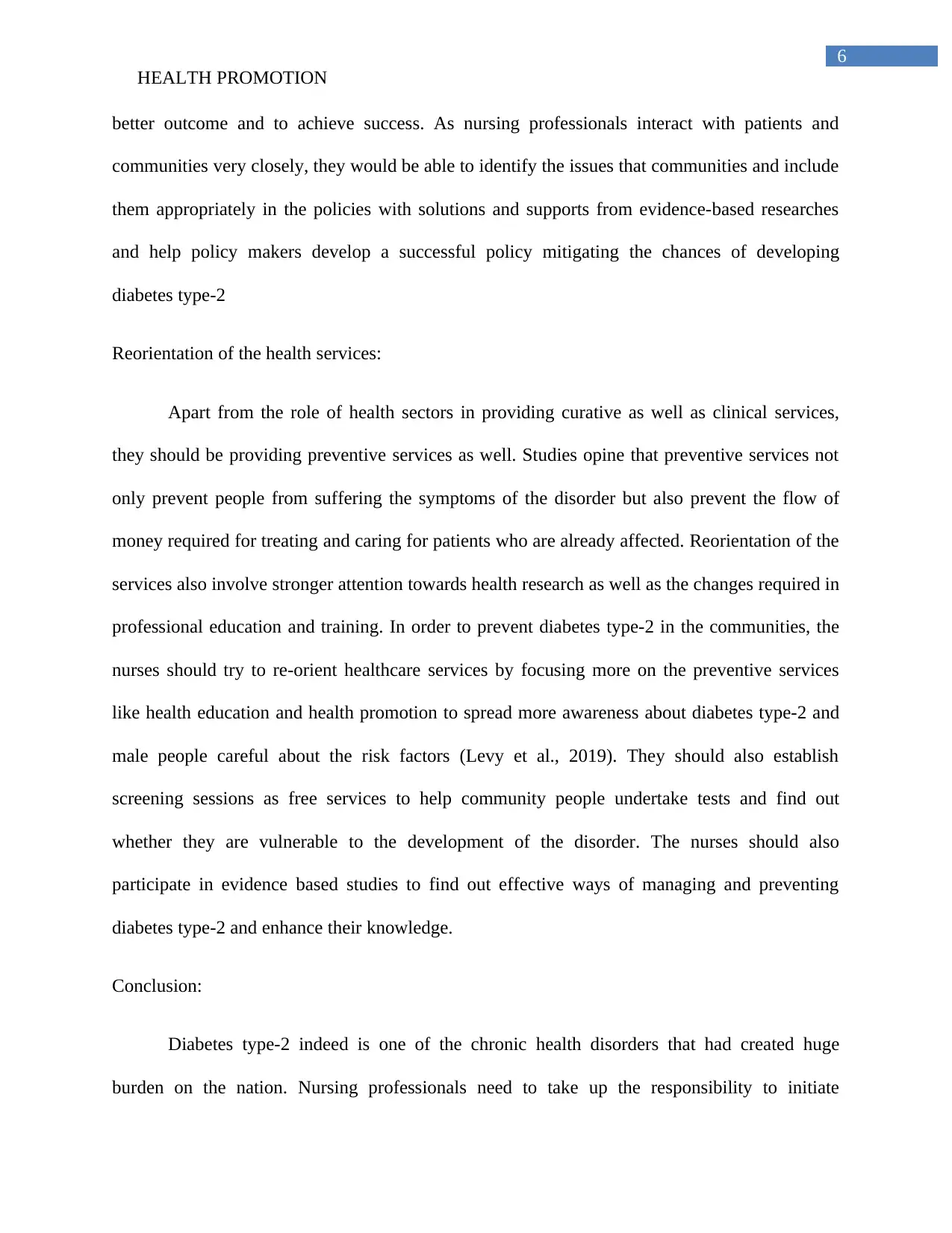
6
HEALTH PROMOTION
better outcome and to achieve success. As nursing professionals interact with patients and
communities very closely, they would be able to identify the issues that communities and include
them appropriately in the policies with solutions and supports from evidence-based researches
and help policy makers develop a successful policy mitigating the chances of developing
diabetes type-2
Reorientation of the health services:
Apart from the role of health sectors in providing curative as well as clinical services,
they should be providing preventive services as well. Studies opine that preventive services not
only prevent people from suffering the symptoms of the disorder but also prevent the flow of
money required for treating and caring for patients who are already affected. Reorientation of the
services also involve stronger attention towards health research as well as the changes required in
professional education and training. In order to prevent diabetes type-2 in the communities, the
nurses should try to re-orient healthcare services by focusing more on the preventive services
like health education and health promotion to spread more awareness about diabetes type-2 and
male people careful about the risk factors (Levy et al., 2019). They should also establish
screening sessions as free services to help community people undertake tests and find out
whether they are vulnerable to the development of the disorder. The nurses should also
participate in evidence based studies to find out effective ways of managing and preventing
diabetes type-2 and enhance their knowledge.
Conclusion:
Diabetes type-2 indeed is one of the chronic health disorders that had created huge
burden on the nation. Nursing professionals need to take up the responsibility to initiate
HEALTH PROMOTION
better outcome and to achieve success. As nursing professionals interact with patients and
communities very closely, they would be able to identify the issues that communities and include
them appropriately in the policies with solutions and supports from evidence-based researches
and help policy makers develop a successful policy mitigating the chances of developing
diabetes type-2
Reorientation of the health services:
Apart from the role of health sectors in providing curative as well as clinical services,
they should be providing preventive services as well. Studies opine that preventive services not
only prevent people from suffering the symptoms of the disorder but also prevent the flow of
money required for treating and caring for patients who are already affected. Reorientation of the
services also involve stronger attention towards health research as well as the changes required in
professional education and training. In order to prevent diabetes type-2 in the communities, the
nurses should try to re-orient healthcare services by focusing more on the preventive services
like health education and health promotion to spread more awareness about diabetes type-2 and
male people careful about the risk factors (Levy et al., 2019). They should also establish
screening sessions as free services to help community people undertake tests and find out
whether they are vulnerable to the development of the disorder. The nurses should also
participate in evidence based studies to find out effective ways of managing and preventing
diabetes type-2 and enhance their knowledge.
Conclusion:
Diabetes type-2 indeed is one of the chronic health disorders that had created huge
burden on the nation. Nursing professionals need to take up the responsibility to initiate
Paraphrase This Document
Need a fresh take? Get an instant paraphrase of this document with our AI Paraphraser
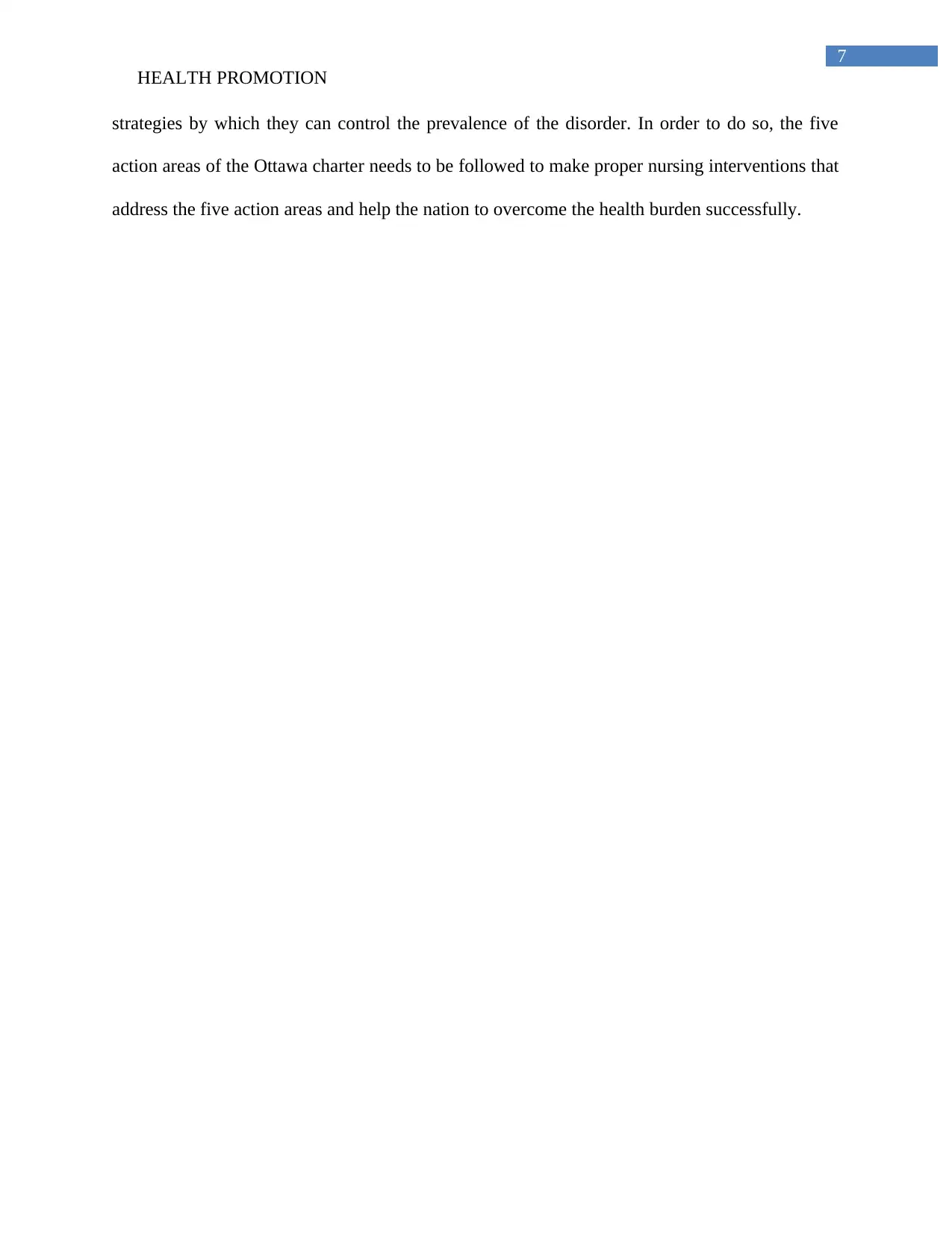
7
HEALTH PROMOTION
strategies by which they can control the prevalence of the disorder. In order to do so, the five
action areas of the Ottawa charter needs to be followed to make proper nursing interventions that
address the five action areas and help the nation to overcome the health burden successfully.
HEALTH PROMOTION
strategies by which they can control the prevalence of the disorder. In order to do so, the five
action areas of the Ottawa charter needs to be followed to make proper nursing interventions that
address the five action areas and help the nation to overcome the health burden successfully.
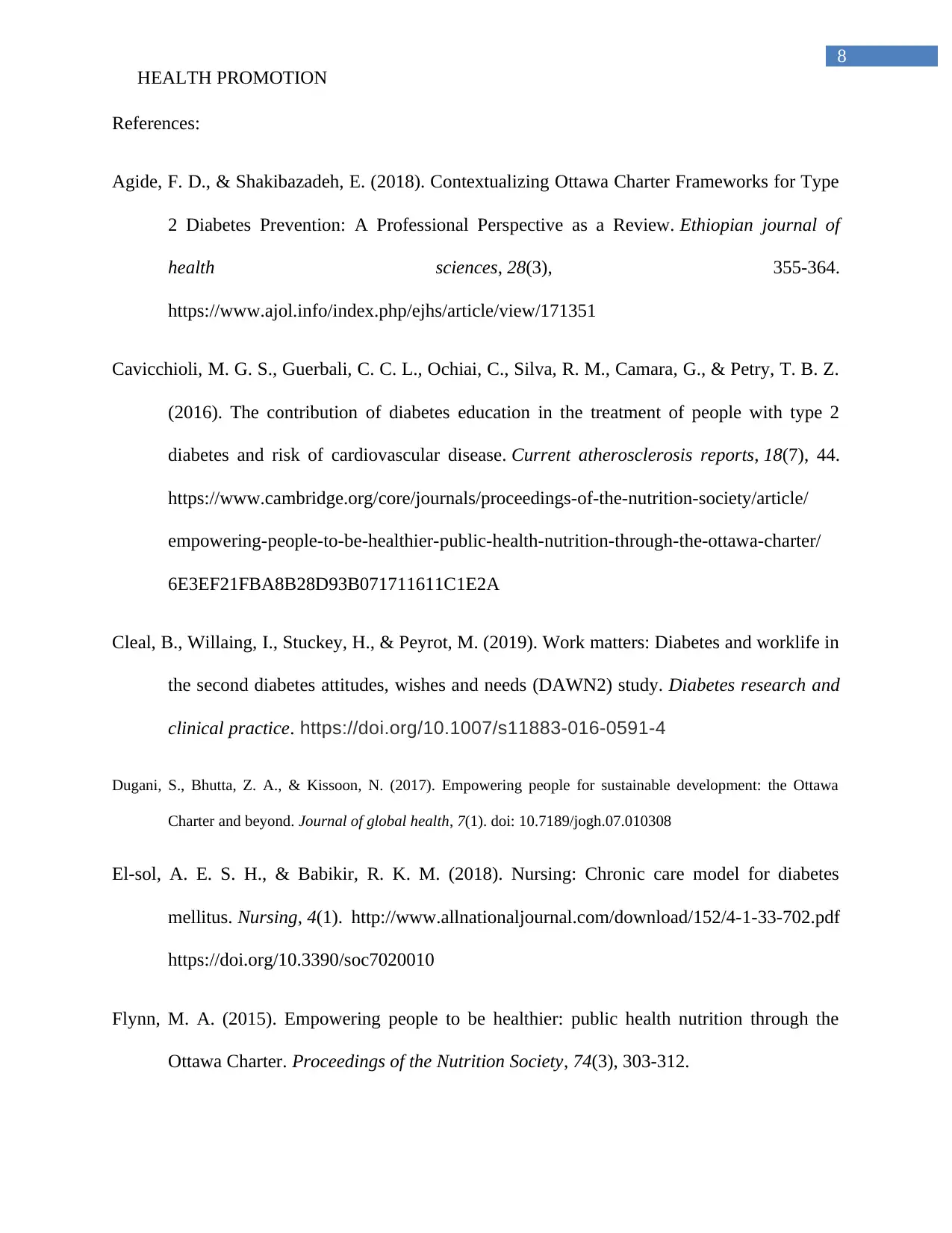
8
HEALTH PROMOTION
References:
Agide, F. D., & Shakibazadeh, E. (2018). Contextualizing Ottawa Charter Frameworks for Type
2 Diabetes Prevention: A Professional Perspective as a Review. Ethiopian journal of
health sciences, 28(3), 355-364.
https://www.ajol.info/index.php/ejhs/article/view/171351
Cavicchioli, M. G. S., Guerbali, C. C. L., Ochiai, C., Silva, R. M., Camara, G., & Petry, T. B. Z.
(2016). The contribution of diabetes education in the treatment of people with type 2
diabetes and risk of cardiovascular disease. Current atherosclerosis reports, 18(7), 44.
https://www.cambridge.org/core/journals/proceedings-of-the-nutrition-society/article/
empowering-people-to-be-healthier-public-health-nutrition-through-the-ottawa-charter/
6E3EF21FBA8B28D93B071711611C1E2A
Cleal, B., Willaing, I., Stuckey, H., & Peyrot, M. (2019). Work matters: Diabetes and worklife in
the second diabetes attitudes, wishes and needs (DAWN2) study. Diabetes research and
clinical practice. https://doi.org/10.1007/s11883-016-0591-4
Dugani, S., Bhutta, Z. A., & Kissoon, N. (2017). Empowering people for sustainable development: the Ottawa
Charter and beyond. Journal of global health, 7(1). doi: 10.7189/jogh.07.010308
El-sol, A. E. S. H., & Babikir, R. K. M. (2018). Nursing: Chronic care model for diabetes
mellitus. Nursing, 4(1). http://www.allnationaljournal.com/download/152/4-1-33-702.pdf
https://doi.org/10.3390/soc7020010
Flynn, M. A. (2015). Empowering people to be healthier: public health nutrition through the
Ottawa Charter. Proceedings of the Nutrition Society, 74(3), 303-312.
HEALTH PROMOTION
References:
Agide, F. D., & Shakibazadeh, E. (2018). Contextualizing Ottawa Charter Frameworks for Type
2 Diabetes Prevention: A Professional Perspective as a Review. Ethiopian journal of
health sciences, 28(3), 355-364.
https://www.ajol.info/index.php/ejhs/article/view/171351
Cavicchioli, M. G. S., Guerbali, C. C. L., Ochiai, C., Silva, R. M., Camara, G., & Petry, T. B. Z.
(2016). The contribution of diabetes education in the treatment of people with type 2
diabetes and risk of cardiovascular disease. Current atherosclerosis reports, 18(7), 44.
https://www.cambridge.org/core/journals/proceedings-of-the-nutrition-society/article/
empowering-people-to-be-healthier-public-health-nutrition-through-the-ottawa-charter/
6E3EF21FBA8B28D93B071711611C1E2A
Cleal, B., Willaing, I., Stuckey, H., & Peyrot, M. (2019). Work matters: Diabetes and worklife in
the second diabetes attitudes, wishes and needs (DAWN2) study. Diabetes research and
clinical practice. https://doi.org/10.1007/s11883-016-0591-4
Dugani, S., Bhutta, Z. A., & Kissoon, N. (2017). Empowering people for sustainable development: the Ottawa
Charter and beyond. Journal of global health, 7(1). doi: 10.7189/jogh.07.010308
El-sol, A. E. S. H., & Babikir, R. K. M. (2018). Nursing: Chronic care model for diabetes
mellitus. Nursing, 4(1). http://www.allnationaljournal.com/download/152/4-1-33-702.pdf
https://doi.org/10.3390/soc7020010
Flynn, M. A. (2015). Empowering people to be healthier: public health nutrition through the
Ottawa Charter. Proceedings of the Nutrition Society, 74(3), 303-312.
⊘ This is a preview!⊘
Do you want full access?
Subscribe today to unlock all pages.

Trusted by 1+ million students worldwide
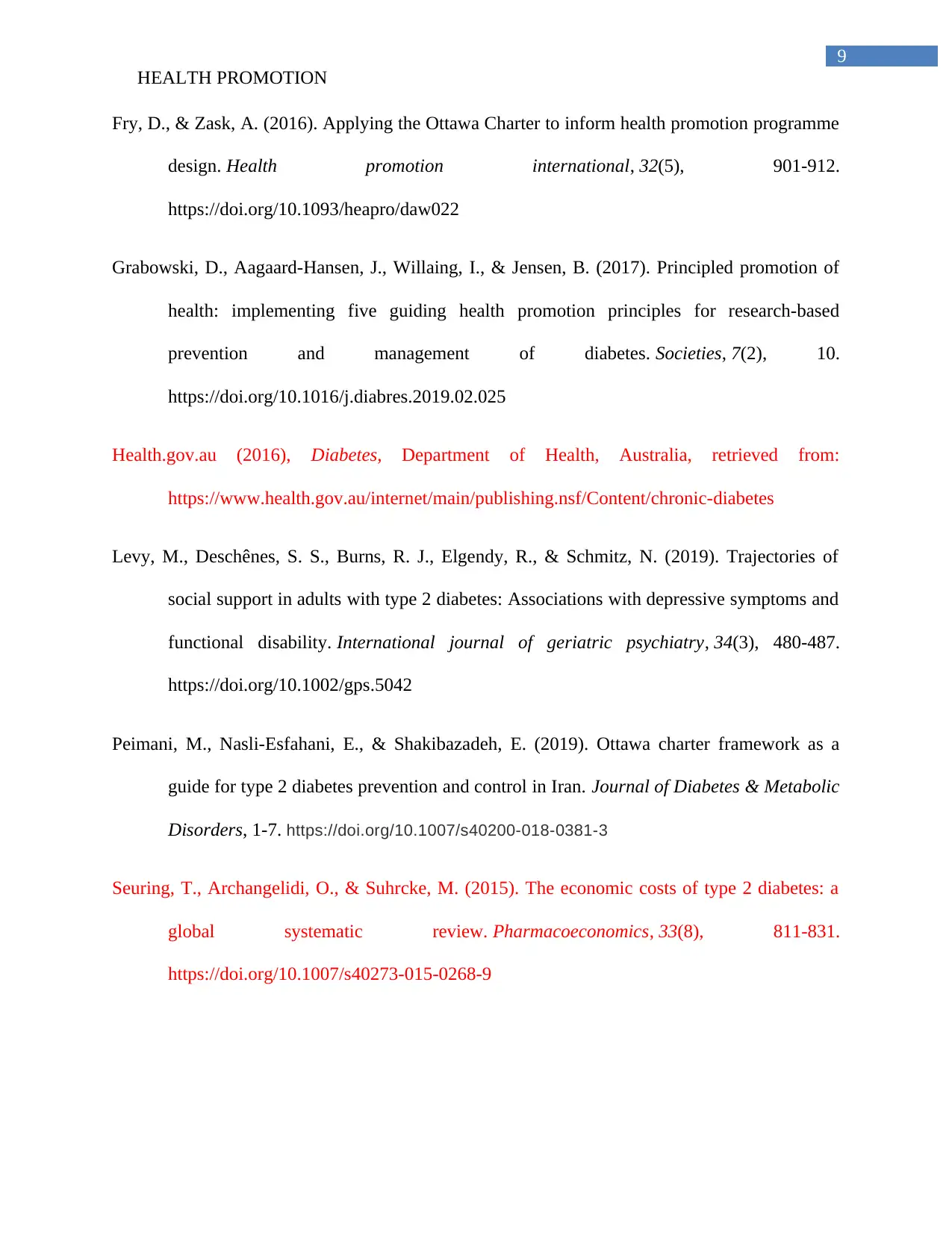
9
HEALTH PROMOTION
Fry, D., & Zask, A. (2016). Applying the Ottawa Charter to inform health promotion programme
design. Health promotion international, 32(5), 901-912.
https://doi.org/10.1093/heapro/daw022
Grabowski, D., Aagaard-Hansen, J., Willaing, I., & Jensen, B. (2017). Principled promotion of
health: implementing five guiding health promotion principles for research-based
prevention and management of diabetes. Societies, 7(2), 10.
https://doi.org/10.1016/j.diabres.2019.02.025
Health.gov.au (2016), Diabetes, Department of Health, Australia, retrieved from:
https://www.health.gov.au/internet/main/publishing.nsf/Content/chronic-diabetes
Levy, M., Deschênes, S. S., Burns, R. J., Elgendy, R., & Schmitz, N. (2019). Trajectories of
social support in adults with type 2 diabetes: Associations with depressive symptoms and
functional disability. International journal of geriatric psychiatry, 34(3), 480-487.
https://doi.org/10.1002/gps.5042
Peimani, M., Nasli-Esfahani, E., & Shakibazadeh, E. (2019). Ottawa charter framework as a
guide for type 2 diabetes prevention and control in Iran. Journal of Diabetes & Metabolic
Disorders, 1-7. https://doi.org/10.1007/s40200-018-0381-3
Seuring, T., Archangelidi, O., & Suhrcke, M. (2015). The economic costs of type 2 diabetes: a
global systematic review. Pharmacoeconomics, 33(8), 811-831.
https://doi.org/10.1007/s40273-015-0268-9
HEALTH PROMOTION
Fry, D., & Zask, A. (2016). Applying the Ottawa Charter to inform health promotion programme
design. Health promotion international, 32(5), 901-912.
https://doi.org/10.1093/heapro/daw022
Grabowski, D., Aagaard-Hansen, J., Willaing, I., & Jensen, B. (2017). Principled promotion of
health: implementing five guiding health promotion principles for research-based
prevention and management of diabetes. Societies, 7(2), 10.
https://doi.org/10.1016/j.diabres.2019.02.025
Health.gov.au (2016), Diabetes, Department of Health, Australia, retrieved from:
https://www.health.gov.au/internet/main/publishing.nsf/Content/chronic-diabetes
Levy, M., Deschênes, S. S., Burns, R. J., Elgendy, R., & Schmitz, N. (2019). Trajectories of
social support in adults with type 2 diabetes: Associations with depressive symptoms and
functional disability. International journal of geriatric psychiatry, 34(3), 480-487.
https://doi.org/10.1002/gps.5042
Peimani, M., Nasli-Esfahani, E., & Shakibazadeh, E. (2019). Ottawa charter framework as a
guide for type 2 diabetes prevention and control in Iran. Journal of Diabetes & Metabolic
Disorders, 1-7. https://doi.org/10.1007/s40200-018-0381-3
Seuring, T., Archangelidi, O., & Suhrcke, M. (2015). The economic costs of type 2 diabetes: a
global systematic review. Pharmacoeconomics, 33(8), 811-831.
https://doi.org/10.1007/s40273-015-0268-9
Paraphrase This Document
Need a fresh take? Get an instant paraphrase of this document with our AI Paraphraser
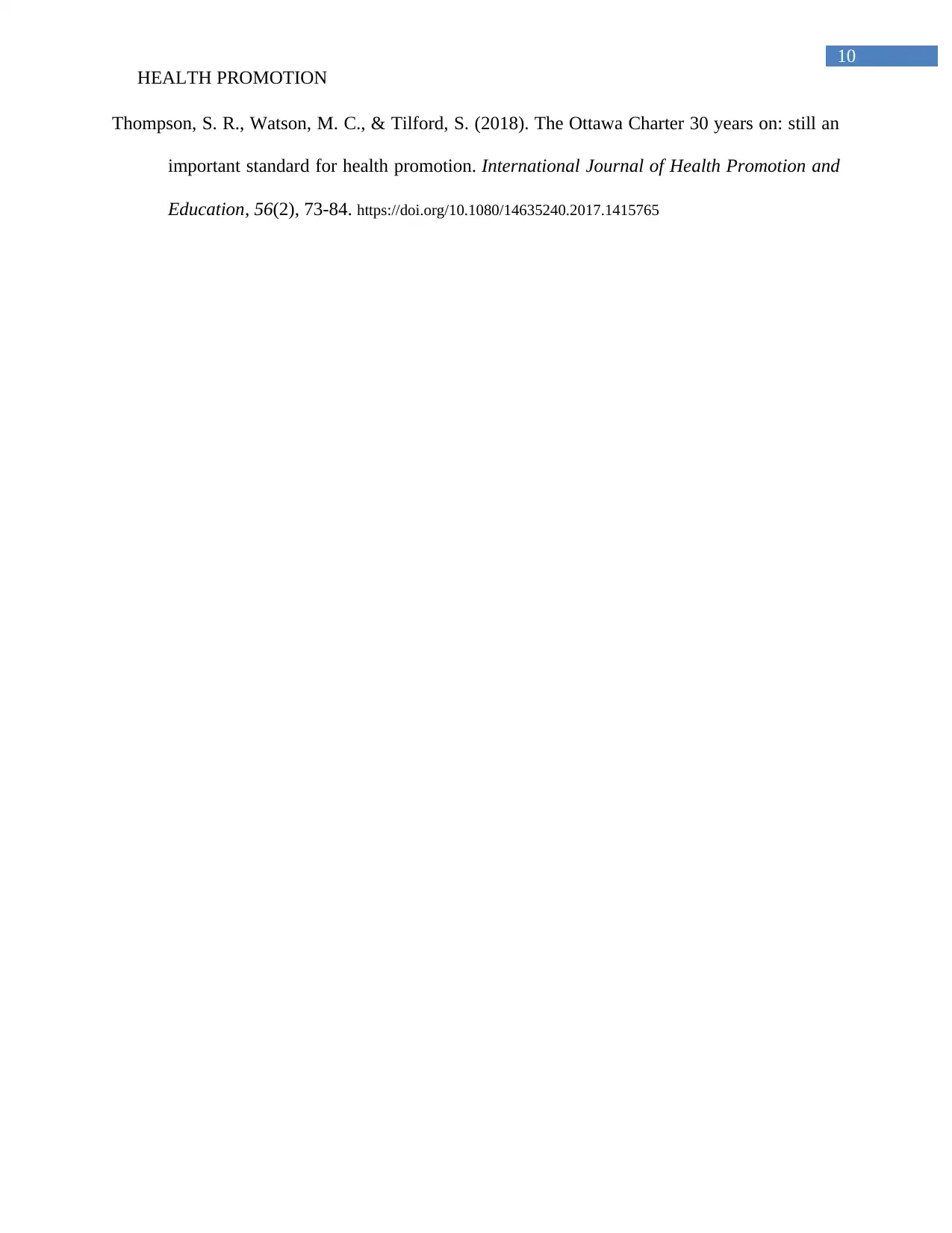
10
HEALTH PROMOTION
Thompson, S. R., Watson, M. C., & Tilford, S. (2018). The Ottawa Charter 30 years on: still an
important standard for health promotion. International Journal of Health Promotion and
Education, 56(2), 73-84. https://doi.org/10.1080/14635240.2017.1415765
HEALTH PROMOTION
Thompson, S. R., Watson, M. C., & Tilford, S. (2018). The Ottawa Charter 30 years on: still an
important standard for health promotion. International Journal of Health Promotion and
Education, 56(2), 73-84. https://doi.org/10.1080/14635240.2017.1415765
1 out of 11
Related Documents
Your All-in-One AI-Powered Toolkit for Academic Success.
+13062052269
info@desklib.com
Available 24*7 on WhatsApp / Email
![[object Object]](/_next/static/media/star-bottom.7253800d.svg)
Unlock your academic potential
Copyright © 2020–2025 A2Z Services. All Rights Reserved. Developed and managed by ZUCOL.





